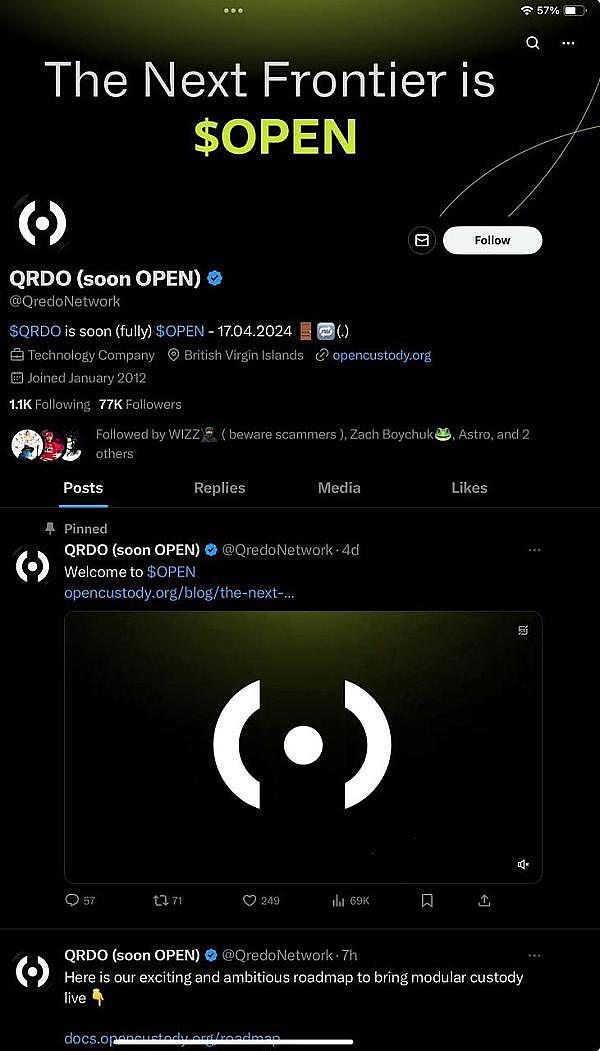Author: 0xmonomi
Recently, according to official news, Qredo announced that it has changed its name to Open Custody Protocol (OPEN).
It is understood that since 2023, Qredo has experienced two large-scale layoffs, and the total number of employees has been reduced from 200 to 50. In particular, on November 2, 2023, the company laid off 50% of its employees again. This series of layoffs seems to have reduced the public's confidence in Qredo. However, Qredo's announcement of a name change may not only represent a reshaping of its brand image, but also mark a fundamental shift in the company's strategy.

The following is a detailed interpretation of the name change.
The name change implies an upgrade of the technical route and a more accurate solution to the market pain points
The new name reflects the company's strategic move towards open and decentralized custody solutions, aiming to provide a wider range of services through innovative technologies. This transformation may be a signal that Qredo is ushering in spring, indicating that it will reposition itself in the future crypto market with a new attitude.
In addition, OPEN's new strategy focuses on optimizing the security and liquidity of crypto assets by leveraging its second-layer protocol and distributed multi-party computation (MPC) technology. Through these technologies, OPEN aims to eliminate the pain points in traditional crypto custody, such as high dependency and security risks, thereby providing customers with stable and reliable services in a turbulent market environment. These measures demonstrate OPEN's rapid response to market demand and commitment to innovation, and are expected to set off a new wave in the field of crypto custody.
As the crypto market continues to evolve, solving the problem of on-chain asset custody has become particularly critical, and OPEN Custody Protocol (formerly Qredo) is gradually rewriting the future of crypto asset management with its innovative solutions in decentralized custody. The core advantages of OPEN Protocol lie in its unique second-layer blockchain technology and multi-party computation (MPC) technology, which work together to not only solve the risks of centralization of traditional custody services, but also greatly improve the flexibility and security of asset management.
OPEN enables enterprises to respond quickly in dynamically changing markets by enabling instant transaction processing and providing a one-stop asset management dashboard. In addition, its seamless integration with corporate financial systems and its natural adaptation to various international compliance requirements mark the practicality and forward-looking nature of the OPEN protocol in the global financial market.
However, despite OPEN's innovative breakthroughs in the field of crypto custody, the issue of interoperability in the entire blockchain industry remains a challenge. The issues of cross-chain communication and multi-chain communication need to be solved through continuous technological iteration and innovation. At this point, there is still great potential and demand for the future development of the OPEN protocol, and it is necessary to continuously explore safer and more efficient solutions to optimize its network architecture and expand its capabilities.

With the launch of OPEN Protocol, the protocol plans to use the accumulated funds to drive growth through acquisitions, product development and geographical expansion, although the recent bearish sentiment in the market has made layoffs necessary. OPEN's transformation is expected to fill a significant gap in the market, namely an open-source, on-chain and cost-effective custody system.
Of course, the OPEN platform remains committed to its mission to provide a decentralized custody solution that not only guarantees the security and autonomy of digital assets, but also promotes the formation of a more resilient and inclusive financial ecosystem. Qredo's transformation to the OPEN custody protocol not only redefines the company's development trajectory, but also enhances its ability to support the rapid needs of the digital economy.
A look at the history of OPEN Custody Protocol and its specific features: Anchoring on-chain financial and asset custody needs
OPEN Custody Protocol (OPEN) was founded in 2018 with the original intention of mitigating the risks associated with centralized custody solutions by enabling secure self-custody services. The rebranded OPEN not only retains the foundational principles of Qredo, but also expands on infrastructure capabilities to serve both institutional and individual investors.
OPEN achieves full decentralization of asset custody through its second-layer blockchain protocol. In this protocol, the private keys of digital assets are managed through a distributed network and are not stored in any single location, greatly enhancing security. This unique structure allows enterprises to flexibly choose self-custody, joint custody, or third-party custody as needed, without having to compromise between security and accessibility.
In response to the FTX collapse and the subsequent distrust of traditional custody services, OPEN optimized its platform to meet the growing demand for reliable self-custody solutions. In May of the same year, it was reported that OPEN had upgraded its self-custodial wallet platform, named "New Qredo", which introduced smart key sharding technology and improved control over team permissions and approval processes.
Although OPEN completed an $80 million Series A financing round led by Coinbase and has accumulated approximately $94 million in venture capital, OPEN had to strategically scale down due to a significant decrease in monthly trading volume in 2023 from an average of $2.5 billion at the end of 2022. This strategic reduction focuses on concentrating efforts on core products such as Web 3 wallets and other custody solutions, in line with the broader movement of decentralized financial (DeFi) infrastructure in the crypto market.
The OPEN protocol supports instant asset transfers, enabling companies to respond quickly in dynamic and ever-changing markets. Financial executives can coordinate and manage assets between custodians, brokers, and financial institutions on the network in real time through a unified dashboard. This not only improves operational efficiency, but also enhances the speed and accuracy of transaction execution.

OPEN runs on open source software, and its RESTful API interface can be directly integrated into the company's financial management system. This feature makes the audit and reporting of digital assets easier, and enterprises can easily access asset information from any device connected to the network to achieve real-time visualization of capital flows.
OPEN uses its advanced blockchain technology to record all transaction activities in an immutable ledger, ensuring audit transparency and permanent preservation of transaction records. In addition, the platform also has powerful messaging capabilities that can handle complex compliance requirements, such as international travel rules, to ensure that the identity information and transaction background of both parties to the transaction are always clear and traceable.
OPEN's security architecture includes seven lines of defense, providing a full range of protection measures from physical hardware to network protocol levels. The introduction of MPC technology not only disperses the risk of private keys, but its distributed execution environment is also insured by Lloyd's of London, providing bank-level security for user assets.
The demand for on-chain asset custody continues to increase, and it is worth looking forward to whether OPEN can play a greater role
With the continuous evolution of the crypto market, solving the problem of on-chain asset custody has become particularly critical, and the OPEN Custody Protocol (formerly Qredo) is gradually rewriting the future of crypto asset management with its innovative solutions in decentralized custody. The core advantage of the OPEN protocol lies in its unique second-layer blockchain technology and multi-party computing (MPC) technology, which work together to not only solve the risks of centralization of traditional custody services, but also greatly improve the flexibility and security of asset management.
OPEN enables enterprises to respond quickly in dynamically changing markets by enabling instant transaction processing and providing a one-stop asset management dashboard. In addition, its seamless integration with corporate financial systems and its natural adaptation to various international compliance requirements are a sign of the practicality and foresight of the OPEN protocol in the global financial market.
However, despite OPEN's innovative breakthroughs in the field of crypto custody, the interoperability problem of the entire blockchain industry remains a challenge. The problems of cross-chain communication and multi-chain communication need to be solved through continuous technological iteration and innovation. At this point, there is still great potential and demand for the future development of the OPEN protocol, and it is necessary to continuously explore safer and more efficient solutions to optimize its network architecture and expand its functions.
Looking forward, we expect the OPEN protocol to not only continue its innovation in decentralized custody technology, but also make new progress in the interoperability, security and user-friendliness of the entire chain dApp. As blockchain technology continues to mature, the continued innovation of platforms such as OPEN will be the key force to drive the entire crypto economy forward. In addition, the possible synergy with other cross-chain technologies such as LayerZero and Axelar also heralds the arrival of a more open and interconnected blockchain network world. Driven by the OPEN protocol, future crypto asset management will be more secure, efficient and transparent.
 JinseFinance
JinseFinance
 JinseFinance
JinseFinance JinseFinance
JinseFinance Coinlive
Coinlive  Bitcoinist
Bitcoinist Bitcoinist
Bitcoinist Cointelegraph
Cointelegraph Cointelegraph
Cointelegraph Cointelegraph
Cointelegraph Cointelegraph
Cointelegraph Cointelegraph
Cointelegraph